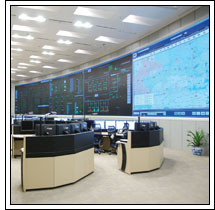
-
Anil Kadam is Smart Grid Senior
Manager, TelventImplementing
Smart Grid in India
will take time, but it
is an absolute
necessity if we
expect to continue
competing in the
global economy.
A smart electrical grid is a
necessity in India. With 1.2
billion people and
approximately one-third who do not
have access to power, there is an
urgent social and economic need for
efficient, reliable and affordable
infrastructure. The future of the
country depends on it.
The rapid growth of our economy
has left our utilities struggling to
keep up with demand: Industrial
customers account for nearly 40 per
cent of the total electricity sold, and
the residential and agriculture
sectors make up the remaining major
users of power. Each of these sectors
are growing, as is the per capita
energy consumption. Electricity
shortages during peak demand times
are commonplace, with demand
exceeding supply by as much as 7-11
per cent at times, according to
Zpryme Research.
The government and regional
utilities are currently implementing
many smart grid pilot projects across
the country. India has also launched
Smart Grid Task Force (ISGTF) and
Smart Grid Forum (ISGF) to tackle
the planning and implementation of
smart grid technologies, along with
dedicating billions for funding
electric generation, transmission,
distribution and power quality.
Despite these projects and
investments, the world’s second
most-populous nation still faces
several major hurdles that it must
overcome before a large-scale smart
grid can become a reality.
CHALLENGES: FROM BASIC
TO LEADING-EDGE
From issues with fundamental
infrastructure, to reliability, to a lack
of knowledge among business and
political leaders, India must quickly
meet the challenges of creating a
basic electricity infrastructure as
well as the challenges of
implementing the latest, innovative
power technology.
Significant line losses, electrical
theft, a patchwork of regulations, the
inconsistency of grid operations, and
the imprecise monitoring and tracking
of electricity all lend to an unstable
network. Utilities are interested in
participating in pilot projects, but are
often too cash-strapped to put up
money for smart grid improvements.
Furthermore, the lack of a regulatory
framework for adopting smart grid
technologies has left utilities feeling
somewhat in the dark and without a
clear path to testing, adoption and
implementation. Progress is being
made with groups like ISGF and
ISGTF making efforts to align all
stakeholders to educate others on
smart grid initiatives.
There is also a need for more
education among utilities
(generation, transmission and
distribution) and government leaders
about the smart grid’s benefits, as there are some who fear it will take
away jobs. On the contrary,
implementing an infrastructure of this
size and scale will require huge numbers
of skilled workers and improve the
quality of jobs available.
This leads to another significant
challenge, which is a rather ironic one.
Although the world knows India for our
stellar engineering and technical
expertise, we lack a sizeable workforce
to tackle the smart grid challenges
within the utilities generation,
transmission and distribution sectors.
Software development is often the career
of choice among our best and brightest,
but working abroad or in the corporate
sector is typically more appealing (and
lucrative). Building the infrastructure
that will make India a sustainable global
superpower must also be an attractive
prospect to our scientists and engineers.
In order to help both utilities and users
recognize the benefits of smart grids,
India must invest in and apply a
systematic methodology on smart grid
knowledge and capacity building among
the stakeholders.
 ADMS & AMI: KEY SOLUTIONS
ADMS & AMI: KEY SOLUTIONS
The government is supporting several
supply-side efforts, including more
advanced electrical systems, SCADA in
major cities and towns, and distribution
solutions for companies to better handle
demand response. Specifically, endload
shedding with a combination of
direct control and differential pricing
will increase the reliability of power
through robust systems with selfhealing
capabilities. These solutions
will help operators better understand
where every kilowatt hour is going in
real-time. There is also a push for
integrating renewable energy on a
massive scale to decrease carbon
dioxide pollutions, as well as India’s
considerable dependence on outside
energy sources.
The smart grid is made up of many
components and technologies, but in
India there is a particularly strong drive
for ADMS (Advanced Distribution
Management System) & AMI
(Advanced Metering Infrastructure)
projects. With ADMS utilities can
better manage supply side asset
efficiency, and with AMI huge volumes
of demand-side data are gathered from
multiple networks that help track more
accurate measurements of electricity
usage. Utilities use this data to better
plan capacity, demand peaks and to
ensure more reliable power. The Indian
government is on-board with plans to
significantly invest in both ADMS and
AMI, and large consumers from the
commercial and industrial sectors are
anxiously awaiting the technology to
alleviate their inconsistent access to
power. Suppliers from around the world
are actively working on ADMS and AMI
technology that addresses the unique
national and local needs in the country.
On the demand side, consumers also
need to be more involved. Beyond using
energy efficiency technologies, their
participation in advanced metering
pilot projects will help bring more
awareness to the broader public of how
the smart grid can improve their daily
lives. Most of these pilot projects should
begin in 2013, with completion and
analysis starting in 2015. There is
already a predicted sharp increase in
the number of smart meters deployed in
India over the next several years, so
these projects will provide valuable
lessons on how best to plan, integrate
and maintain AMI systems. This
technology stands to be one of the first
great leaps to bridging the gap between
ensuring basic infrastructure and
launching a smart grid.
INACTION IS NOT AN OPTION
Implementing a smart grid in India will
take time, but it is an absolute necessity
if we expect to continue competing in the
global economy. Its implementation will
likely move rapidly as pilot projects are
completed and the economic and social
benefits are widely realized. Although
there are many challenges to overcome,
India’s hunger for power is only
surpassed by the capacity of our people’s
innovation and determination to see the
smart grid become a reality.